Dutch Dressage – What is it? – with Christopher Hector
When it was announced that Edward Gal’s return from his break from the ring would be a Masterclass, on the first night of the Amsterdam Show, I started thinking about Dutch Dressage, just what defines it?
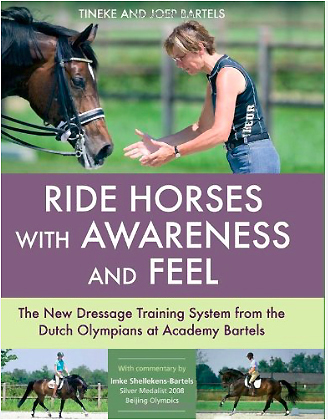
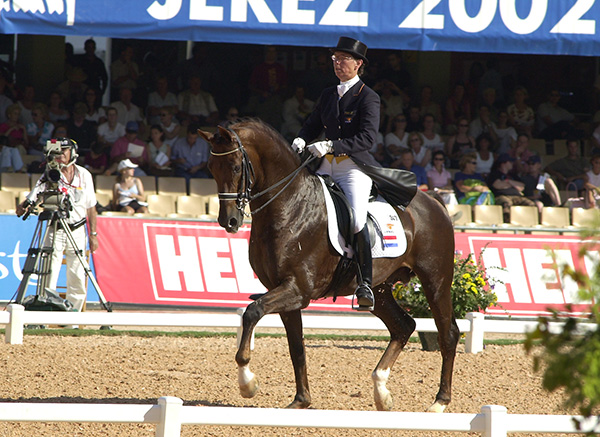
Tineke Bartels and the stallion, Jazz, team members at the WEG in 2002
Imke Schellekens-Bartels in her introduction to Ride Horses with Awareness and Feel – The new dressage training system from the Dutch Olympians at Academy Bartels, the book written with her parents Tineke and Joep Bartels in 2006, writes:
“We have not broken away from the classical system of training – in which my mother was trained, too – but we have modified that system and we have advanced. We find it interesting that the main subject of attention when the discussion of ‘riding deep and round’ comes up in the horse world is the horse’s head position, while the goal of the Academy Bartels training method – improving the horse’s gymnastic development and eliminating mental and physical blockages – is talked about less.”
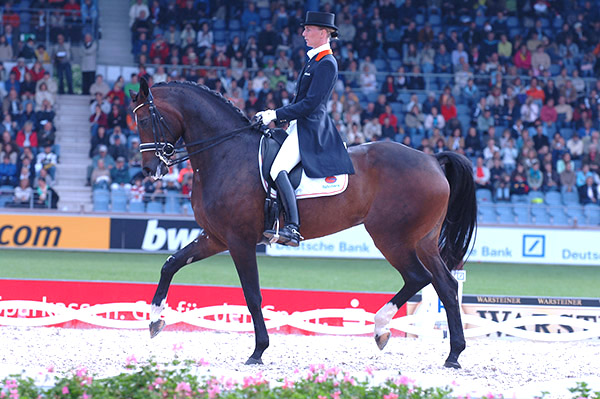
Imke Schellekens-Bartels and Sunrise, members of the Gold Medal WEG Dutch team in 2010
“We are convinced that innovation in training horses for sport is still in its infancy… Perhaps we will have something like a ‘Dutch dressage school’ in the future, in which case we will no longer need to use the German word Durchlässigkeit to describe the goal of our training; instead, we can just say that we want the horse to be ‘open’ to the rider.”
From the book
“Scientific research has shown the positive effects of training deep and round, provided it is done correctly. Riders and trainers who use this method responsibly have learned from experience that it makes their horses relaxed, loose and obedient. In the Netherlands, the method is continually evolving. Perhaps in the future we will talk about the ‘Dutch school of dressage.’
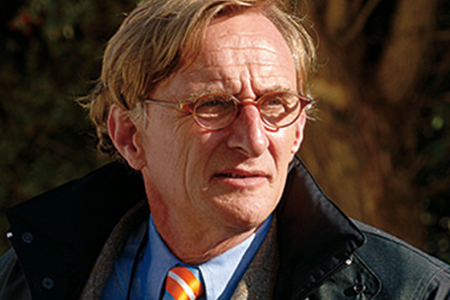
Recently I wrote to Joep, asking him if he thought that twenty years later, the prediction had come true? As usual, Joep’s reply was detailed and thoughtful, even if I disagree with it wildly, of that, more later…
Here’s Joep’s reply:
“Twenty years later it is easy to look back and judge. But no, there is not a Dutch school. There is just one school to ride correctly. Riding forward-downward, stretching the neck and relaxing the body is a prominent part of it. There was a time that this was underestimated and there were too many schenkelgangers. It was good that more attention was paid to riding forward downward, mainly initiated by trainer Schulten Baumer. And then we learned from scientific research that a lower head position had a positive influence on the use of the long body muscles and the movements. Your Australian scientists contributed! But then some top riders went in a wrong direction, Not downwards and long but deep and short. The reaction was tension and lack of relaxed movements. Thank goodness we have more riders nowadays who ride correctly and we have seen marvellous tests recently, from our Dutch riders and foreign riders trained over here.”
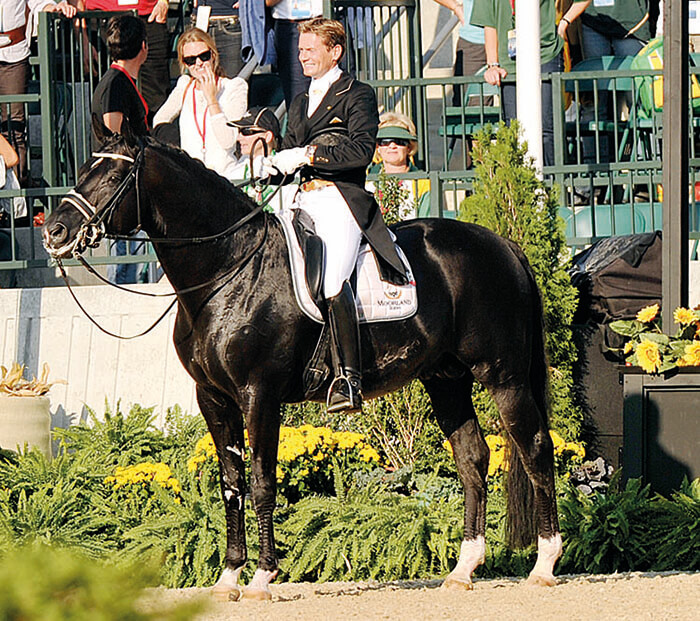
Edward Gal and Totilas waiting for their score at the WEG in Lexington
“In my opinion the sport has been improved over the more than 60 years that I am part of it. As an example of the deep and short period, Edward Gal was shamed, insulted and even severely threatened, mainly through the internet. That is why he disappeared from the sport for a very long period. He is no friend and I have not met him since years but, whatever you think of his riding, he did not deserve this, in my opinion. Please keep this in mind when you judge his career and acknowledge that there was a time that the judges and the spectators loved big, almost unnatural movements. Thank goodness, it seems to me that this time is over nowadays and people prefer to see the relaxed movements which make our sport so beautiful.”
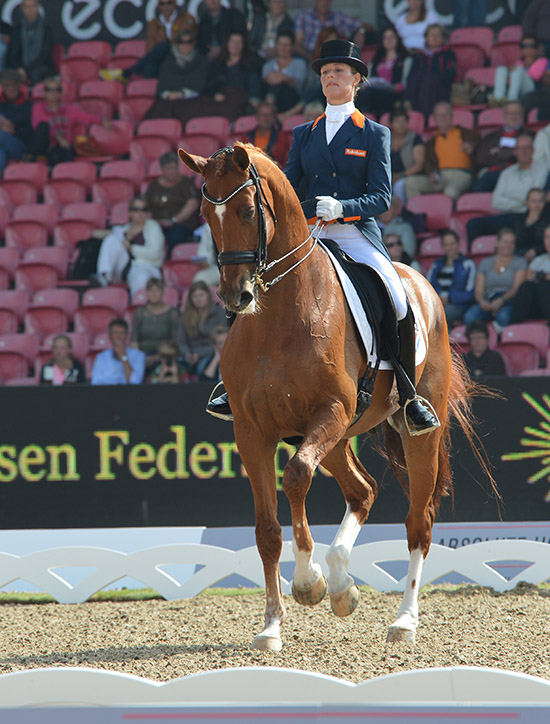
Adelinde Cornelissen and Parzival at Aachen
At the time Joep, Tineke and Imke wrote their book, Dutch dressage was riding high, the Dutch Team, coached by Sjef Janssen, of Edward Gal & Totilas, Hans Peter Minderhoud & Nadine, Adelinde Cornelissen & Parzival and Imke Schellekens-Bartels & Sunrise, had just won the Gold Medal at the 2010 WEG in Lexington and they were seemingly destined to repeat that success at the London Games two years later. Then it all fell apart, a couple of wily Germans lured away Totilas, and suddenly the Gal camp and the Janssen camp were trading insults, and at London, the best they could do was bronze, and more importantly Carl Hester and Charlotte Dujardin had shown the world (and convinced the judges) that calm, relaxed dressage was far more beautiful than its spectacular predecessor.
While the earlier Dutch born coaches of the Team, Jo Rutten and Henk van Bergen, drew inspiration from the German Principles of Training and trained on the same lines, Joep Bartels tells me there were some home grown touches: “Yes, there was of course German influence. But they both were mainly influenced by (and trained by) a Dutch trainer/writer named Ernest van Loon, who promoted the system of training with a low and long neck (‘forward-downward’) back in the eighties. Ernest and his brother Max competed at Olympic level in eventing. Henk van Bergen is still around as a member of the supervisory panel of the FEI.”
Interesting that Reiner Klimke told me that when he came to dressage from eventing, he started warming in his dressage horses in a more forward, deeper and relaxing way, while Dr Schulten-Baumer came to dressage from jumping and that influenced his deeper more forward way of working his dressage horses. The truth is all the German trainers, ride their horses long, and low, and in doing so, come a bit behind the vertical – though this is nothing like horses with their jaws hauled into their chests à la Sjef.
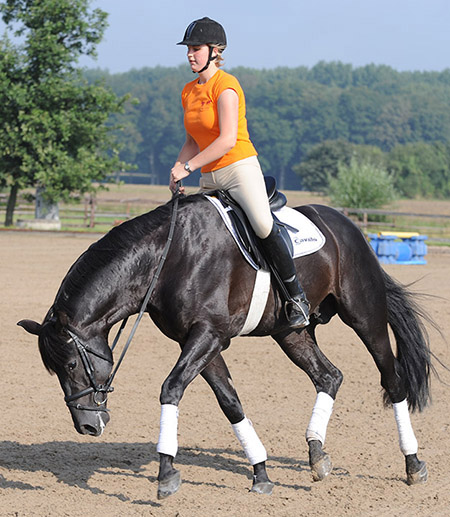
Ingrid Klimke’s bereiter demonstrates Dr Klimke’s ‘lip to the sand’ with Dresden Man
One of the first Dutch stars had been Annie van Doorne who started as a High School rider in the Dutch circus ‘tHoefke, her trainer was the former Chief Rider of the Spanish Riding School, Franz Rochowansky – he went on to be an influential teacher in Britain (Carl Hester quotes him) and the United States. Annie represented Holland at the 1972 Games after winning three Dutch Championships in the 60’s.
Looking at World Championships as a guide to where the Dutch team ranked… The first Dutch team medal was in 1986 at Cedar Valley, with silver to a team of Anne Marie Sanders-Keyzer and Amon, Bert Rutten (trained by his father, Jo Rutten) and Robby, Tineke Bartels and Olympic Duco (trained by Henk van Bergen) and Helen Aubert and Mr X.
Together with Henk van Bergen, Jo Rutten was Dutch team trainer in the late 1980s before he resigned in 1989 because he did not agree with the judging at the Dutch Championships that year.
Henk van Bergen was the son of a baker, and he worked his way up through the ranks of the local Brakkenstein Dressage Stable as a young man, and he eventually purchased the beautiful property, developing the business into a successful dressage training facility, as well as the host site for the Dutch National Championships for over 20 years. He coached the Dutch Dressage Team at both the 1972 and 1992 Olympic Games. He became a popular clinician all over the world, his most recent dressage role was at the 2022 World Championships in Herning where he was a member of the supervisory judges panel.
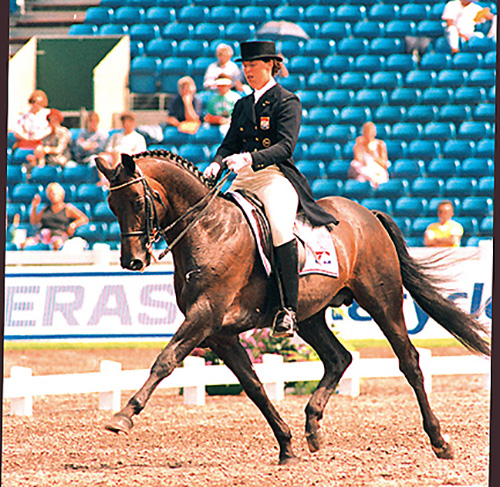
Ellen Bontje and Heuriger at The Hague
In 1994 in The Hague it was WEG Silver again with Sven Rothenberger and Dondolo and Ellen Bontje and Heuriger both of whom trained with German professional, Conrad Schumacher. But for the first time, Sjef appears as the trainer of Anky van Grunsven and Bonfire.
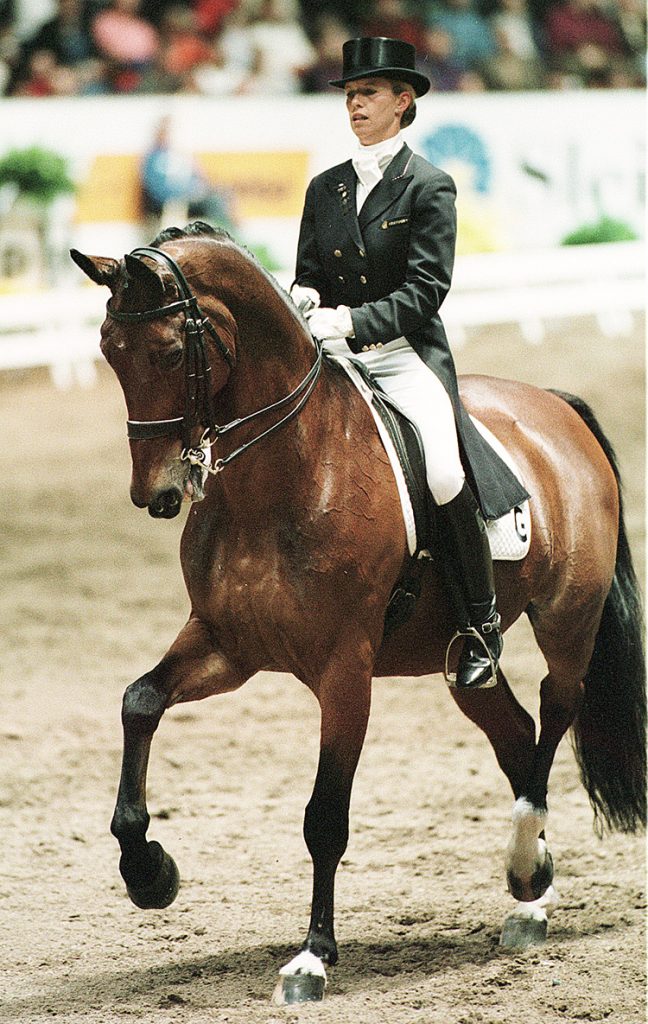
With the appearance of Sjef as coach in 1994 we have something very new, and as the dressage world discovered, quite confronting, Sjef had his own methods for both horse and rider.
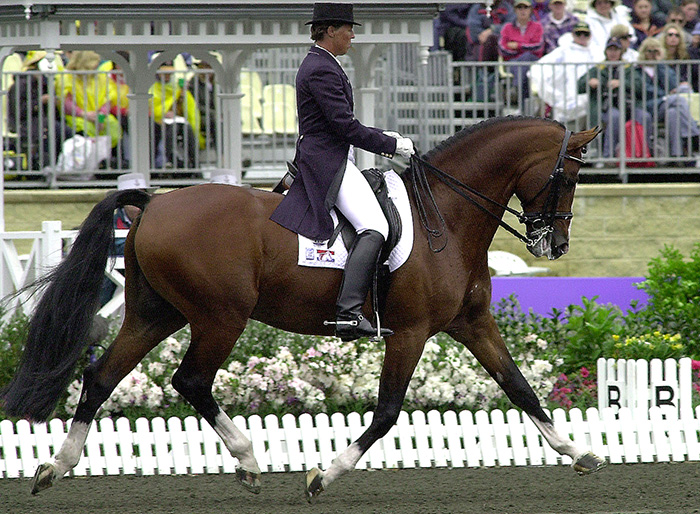
Ellen Bontje and Silvano
At the 1998 WEG in Rome, it was silver once again. This time the team was Ellen Bontje and Silvano, Gonnelien Rothenberger and Dondolo (both trained by Schumacher), Coby van Baalen and Ferro (Coby initially trained with Henk van Bergen and later with Jo Rutten, but in 1989, Coby started training with German professional, Jo Hinnemann) along with Anky who was second with Bonfire in the Freestyle.
Bonfire is retired and the Dutch re-appear on the podium eight years later in 2006 in Aachen to again take silver.
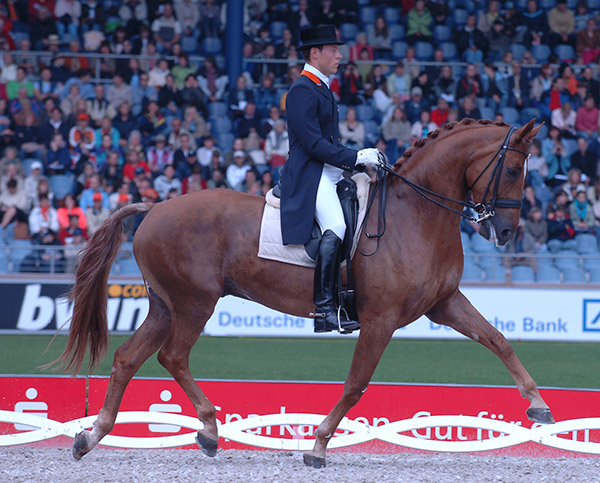
Lauren van Lieren and Ollright
By now we have a team that follows the training techniques and philosophy of their coach, Sjef Janssen: Imke Schellekens-Bartels and Sunrise, Laurens van Lieren and Ollright, Edward Gal and Lingh, along with Anky and Salinero.
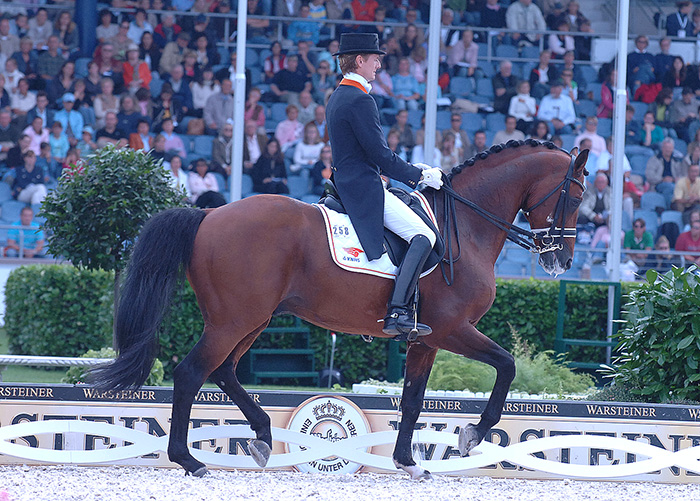
Edward Gal and Lingh
But already, the Sjef system is coming under fire…
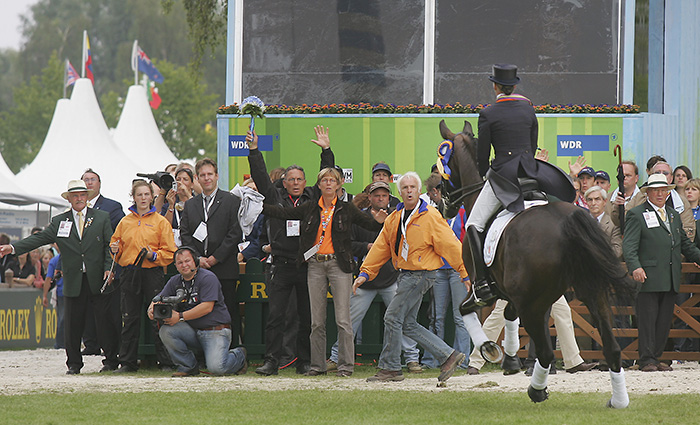
Dutch officials trying to stop Salinero as he heads for the stables at Aachen
There was a disgraceful moment at the Aachen medal giving ceremony, when, while the audience eyes were on the flag ascending, Anky slipped off Salinero and swapped on to a stout police horse. The world’s number one dressage rider was not sure she could leave the arena without the world’s number one dressage horse bolting, as he had done on previous occasions.
Coming into the Aachen WEG in 2006, Sjef had been under pressure.
It all blew up spectacularly with an article in the German equestrian magazine, St Georg, published in 2005. The op-ed was headed: Dressage Peverted, with a sub-heading – Crime scene warm-up arena and the observation that:
“There is hardly any competition without debate. The audience complains. Some protested against van Grunsven’s training methods in Las Vegas and increased the pressure on the steward until he eventually approached the Olympic medallist. For Mariette Withages, chairman of the dressage committee of the FEI, it was just a little side comment – well, she just rode Salinero very deep, this is how it is done nowadays. And as the judges only judge what they see during test, the horse and rider combination gained record marks in the freestyle to music and even a 10.0 for their choreography of the German judge Uwe Mechelm. Later, on the phone, questioned about the incident in the warm-up arena, Mechelem claimed not to know anything about it: Oh, did that really happen? It seems as if the judges sometimes resemble the three wise monkeys: blind, deaf and dumb. To open one’s mouth could become rather uncomfortable – after all the rather chummy dressage society meets weekly and it would be upsetting not to remain friends with everyone.”
“This is how it is done nowadays – maybe that is the sticking point. Observations at the warm-up arena during the World Championships of Young Dressage horses: Five and six year old horses, ridden by Dutch riders, are being prepared for their big outings. Seemingly the horses are biting into their own chests. The rider pulls the reins towards his abdomen whilst holding his hands extremely far apart, the head of the horse gets yanked from one side to the other. Then he stops. Repeated pulling, a quick kick with the spurs, the horse trots on. Not even three metres later he stops again: The rider moves his legs away from the horse‘s body, leans back with all his strength. Again the reins get pulled left and right. The horse’s nose is approaching the 45° angle behind the vertical, the neck is tightly rolled. The same moment the horse comes to a standstill, the rider‘s leg gains momentum. Again the spurs, again halting, again left and right on the reins.”
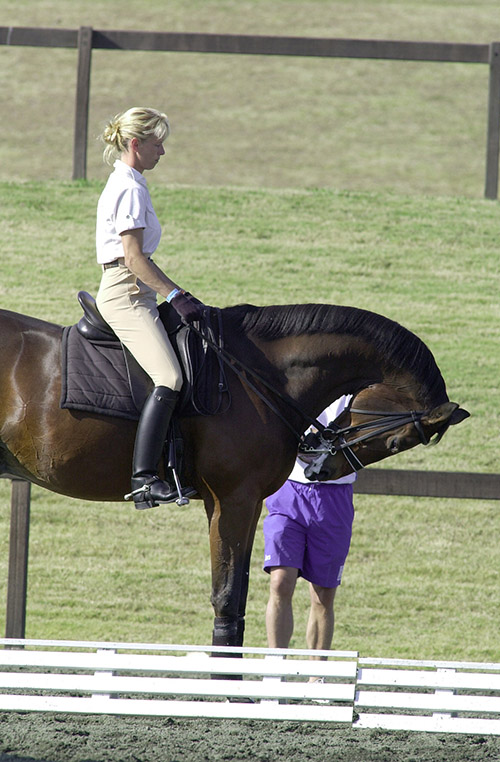
This was the photo of Bonfire, taken at the Sydney Olympics, that initiated threats to THM from Sjef
By this time, Sjef had already acquired a well-founded reputation for threatening to sue publications that printed photos of horses being ridden in the extreme manner his pupils favored (yes THM was one of them) and he took out a personal libel suit against the editor of St Georg, Gabriele Pochhammer.
However the 2010 WEG in Lexington was again a triumph for Sjef with Gold to a team of his disciples: Edward Gal & Totilas, Hans Peter Minderhoud & Nadine, Adelinde Cornelissen & Parzival, Imke Schellekens-Bartels & Sunrise.
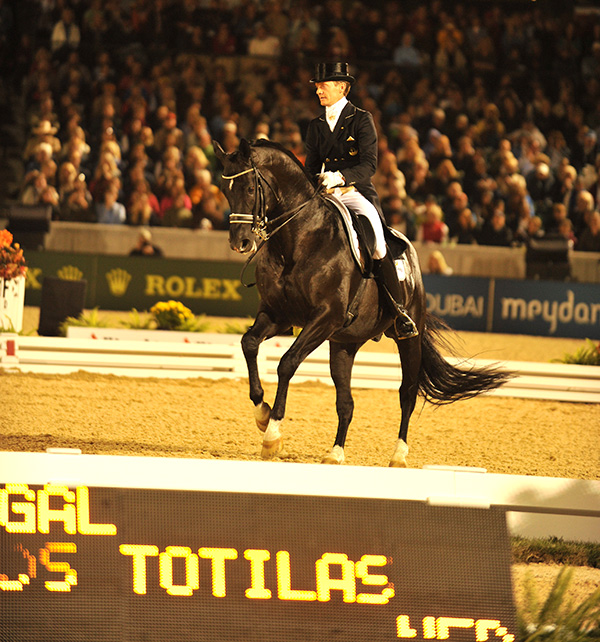
Individually at Lexington, Edward Gal won the Freestyle and the Special with Totilas but soon afterwards the horse was sold. Sjef was appointed coach until the 2012 London Games, but it is not a happy Dutch camp, and by 2013, he had resigned and been appointed coach of the Belgian team. Before we draw the curtain on Sjef and his influence, let’s look at the core of his equestrian philosophy.
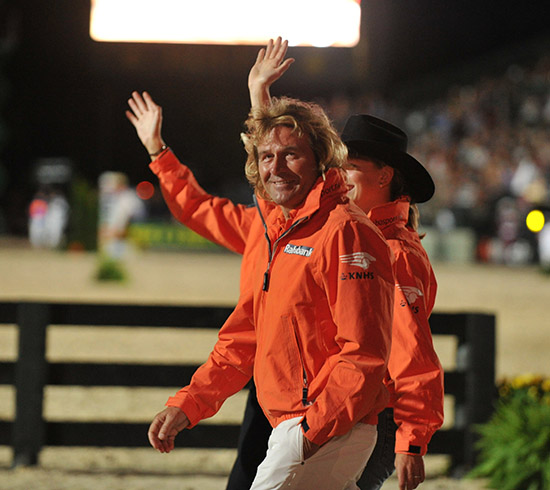
Sjef at the Opening Ceremony at the Lexington WEG
Sjef entered the world of dressage late in life, “My equestrian career started when I was twenty eight years old, married, and on my way to the tennis court several times a week, I took my little daughter with me and we would pass a meadow, and there was a foal in it. She liked that foal, so stupid as I was, I decided to buy it. One thing led to another, a little while later I bought an eighteen month old stallion, Oran, and he was to become my first Grand Prix horse.”
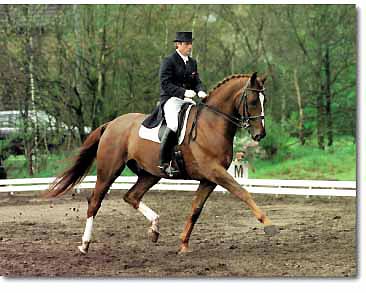
Sjef and his Belgian Hanoverian, Oran
Sjef found equestrian knowledge in Belgium: “Some people had just opened a school in classical dressage riding in Belgium, people who had studied at the Spanish Riding School, with Nuno Oliveira in Portugal, people like that. They had about thirty horses that could do passage, piaffe, pirouette, all the so-called difficult stuff. I decided to go to that school. It was seven hours riding a day, two years in a row – so I did a lot of mileage in two years. Those people were very classical and I like that a lot. At the time I had to work in my own barn also – then I decided to start and compete in Holland.”
“I learned a lot about dressage from the people at the school, they had a lot of technique and splendid horses that let you feel the really good piaffe, and the really good passage and really good pirouettes.”
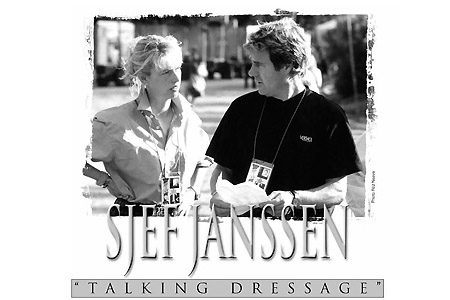
In an interview in 1999 Sjef told me:
“The philosophy behind my work is that number one, I am for classical dressage, the way it is supposed to look in the FEI rules. But my philosophy of training is different, I treat horses like athletes, instead of using the classical training methods because I don’t think they work any more in these modern times. The horses are different, there’s way more Thoroughbred in them, so you have to approach them differently, also mentally. The horses in the past were those really heavy horses, and you didn’t need to train them much in the lower frame because they were very difficult to bend and flex.”
“A lot of people are against our way of training because they think we over bend the horses and that will hurt the neck and the back, but two professors have conducted a research project, and soon there is an article to be published, and they have proved that riding the horse always up, is very dangerous for the horse, and riding them deep is very good for the horse, especially the neck and the flexibility. So what we did unconsciously in our training has now been proven very good for the horse’s well being.”
Riding the horse deep is very different from the way you would have been taught with the very classical instructors you started out with – what made you think of putting the horse in that position?
“I had a very difficult horse, the horse I had bought for my daughter – that yearling colt. He was extremely difficult so he was a very good learning experience for me. I had to invent a lot of stuff, because in the traditional way, I was not able to ride him. I had to experiment a lot, and I started riding him deeper, more over his back, because he had a tendency of hollow his back and go short in the neck – I had to make him round and his frame go longer. That’s actually where it started, and I had very good results with that horse. That was how, he ended up taking me into the Dutch team.”
“It was just a matter of testing and experimenting. I couldn’t get him on the bit, he was extremely difficult in the mouth, very sensitive, you could not even touch him in the mouth or the back would be gone again. I really had to get a connection on my snaffle to make him stretch. It took about a year and a half, and then we finally agreed – okay I’m going to put you real deep and I’m going to get the contact from there and then I can get you longer. He was also very hot and very sensitive to the leg. He was an extremely difficult horse but at the end, we got it.”
When you were developing your philosophy of working the horse deep, were you aware of the deep and round work Dr Schulten-Baumer was doing with Nicole Uphoff and Isabell Werth?
“That’s totally different. I can only comment on what I see at shows, but it is absolutely not our system. We work on being honestly through, and on the bit, they seem to do it a little different, sometimes the connection and the steadiness of the position is not always the same. Sometimes the connection does not seem to be straight and on two reins, sometimes they get a little too deep, and sometimes a little too much over the bit. Sometimes they tilt their head a little bit. That’s what I think is different about what we do. I think we are way more on a very honest connection.”
The problem was that while the theory of deep and low was that it produced a relaxed, athletic horse, the result was anything but. Despite being acclaimed the world’s happiest horse at Global Forum Joep Bartels stage-managed in 2004, the horse was the picture of tension. Ulla Salzgeber later joked that Salinero was only the happiest horse in the world when he was in the competition arena, because he knew Sjef couldn’t get in there with him… It was impossible for Anky to halt the horse, he was covered in sweat, his tail lashed continuously, and his athleticism was confined to his extravagant front legs, while the short steps of his hind legs trailed behind.
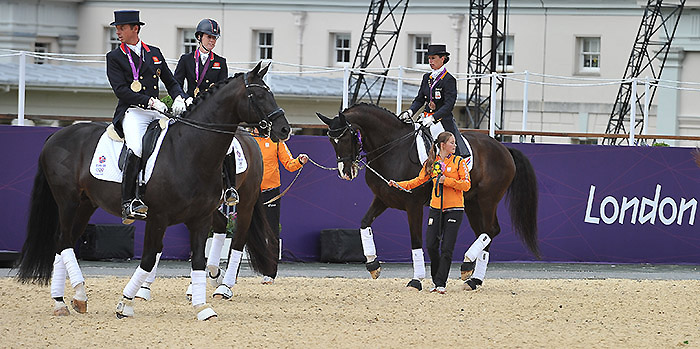
The beginning of one era: Carl Hester and Charlotte Dujardin with their medals at the London Games, and the end of another, Anky and Salinero needing two handlers at the Presentation…
While Sjef is no longer a force today, and while Dutch riders are more careful of the picture they present in the warm up arena, to my way of thinking the current fashion is even more unappealing. At least Anky and Salinero presented in a decent frame, Dutch dressage right now is characterized by hollow backs, and short, jacked up necks, and still that protesting tail rails against the riding, every step of the way, and with all the horses.
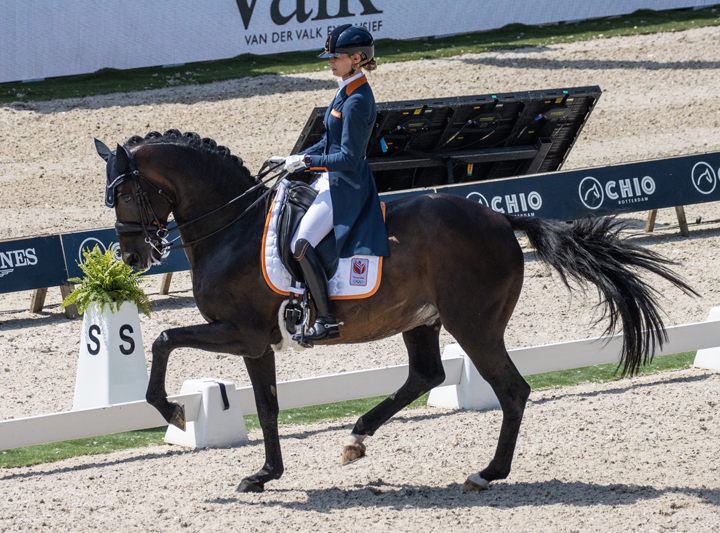
Dinja van Liere and Hermes – there goes that tail
I hear what Joep is saying about Edward Gal, I have met Edward a couple of times and he seems a very nice guy, but a number of his horses have quit the sport when they could no longer handle the pressure. Gribaldi said, ‘enough’, I well remember Lingh bolting down the centre line at Aachen and Undercover said, no more.
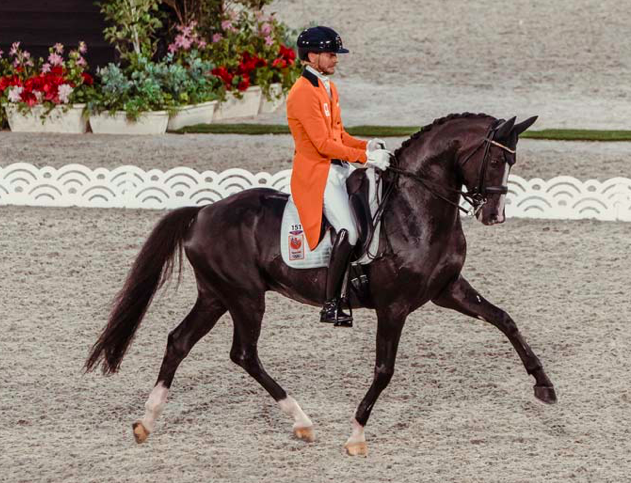
And I really cannot cope with this outline – Edward and Total US
I think there is a fatal flaw in Joep’s suggestion that there are certain techniques that can only be used by brilliant riders on exceptional horses – this is diametrically opposed to the thinking behind the Principles of German Riding, the principles build on the insights of la Guérinière where each exercise is based on – and sympathetic to – the physical and mental development of the horse, every horse. Sure, there will be some horses that never do a great piaffe, or a really expressive change, but every single horse can be progressively improved by following the training scale, even with a less-than-gifted rider. This is in stark contrast to the American discipline of Reining, where the movements in their tests (reining patterns) are the same for two (!) and three year old horses as they are for six year old horses, with no consideration of the relative maturity of the horses.,
The current number one Dutch rider Dinja van Liere was warmed in at the Worlds in Herning by Western trainer, Reike Young. Looking for special tricks especially from a equestrian discipline as horse-unfriendly as reining is a one way road to disaster. As the divine Marlene sang, when will they ever learn…
And yes, Western Reining Training expert, Reike Young was billed as one of the experts to appear at Edward’s Amsterdam Masterclass. Now I am not so naîf as to believe that Edward and his all-star cast are going to come out and start brutalising horses in front of the spectators, nor am I suggesting that they would like to do that. But what happens in master classes is a bit like what happens in judging seminars, you get to hear all the right words which are often promptly forgotten when the real action begins. I remember at the end of one of Joep’s Global Forums, when the world’s leading equitation scientist Andrew McLean announced to the world that he could see nothing wrong with rolkur as practiced by Sjef and Anky. Where did you see them warming up, what competition? I asked. No show, Andrew replied, “I saw their demonstration at the Global Forum! ”
The Edward Gal masterclass presented a striking collection of horses. We started with the black six-year-old stallion, Hexagons Gorgeous Black Art (Toto Jr / Rubequil / Jazz) and Benedek Pachl, the pair were worked in by stud principal, Leunus van Lieren. The lesson was straightforward, one that you can see in any country in the dressage world, collect a few strides, go forward, come and circle me, get him on the hind legs. Don’t push too much with your seat when you collect or you will get too much weight in your hands, but as the work gets more demanding, that beautiful black tail gets more Dutch – like a Windmill. By the time the six year old has finished some piaffe, passage work, he is very tense indeed.
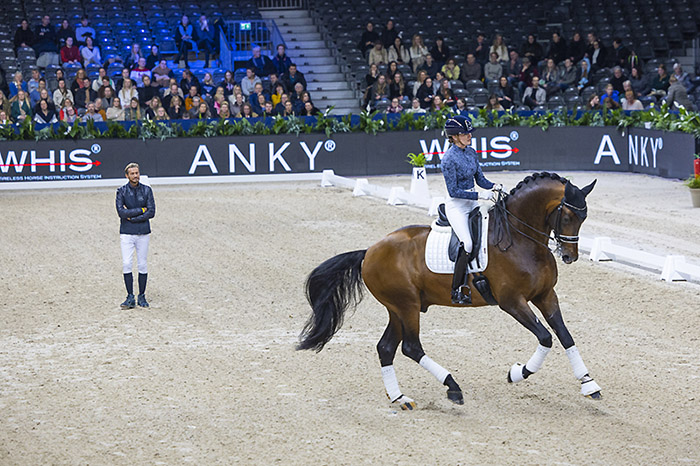
Emmelie Scholtens and Las Vegas working with Edward Gal – image DigiShots
The next stallion in was one of the stars in the six-year-old World Title at Ermelo last year, Las Vegas (Ferdeaux / Winton) ridden as he was then, by Emmelie Scholtens, and this time it is the man himself, Edward Gal, calling the shots.
Like all the horses in the masterclass this glorious stallion is tight and short in the neck and behind the vertical, but you can see that his slight rider’s arms are quite relaxed, and you can see Emmelie working on stretching the big fella. They finish on a long loose rein in an open frame, the horse looks very calm but he is fiddling with his tongue.
Next in, Hans Peter Minderhoud working with long time eyes-on-the-ground for the Gal / Minderhoud team, Nicole Werner. He is riding the bay stallion, Incognito (by the Hotline son, Davino, out of a Vivaldi mare). The bay has been out injured for twelve months coming back. Incognito is short in front, and long behind without any power to carry himself, and he seems very mechanical, there’s no spark, no personality. It’s not particularly Dutch – you can see bad, dominating riding all over the world.
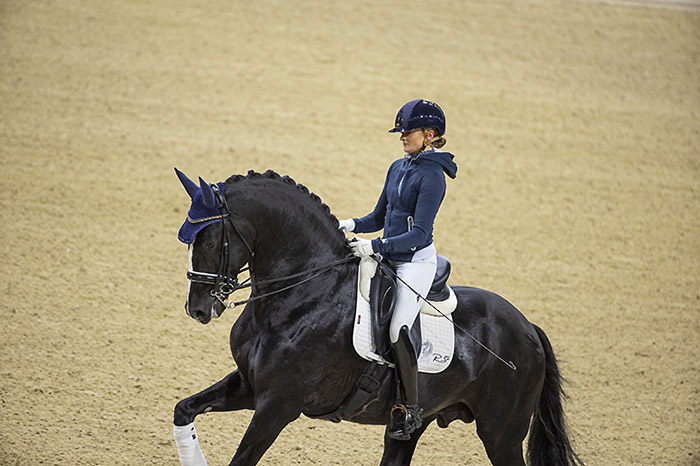
Marieke van de Putten and Jameson RS2 Photo DigiShots
Next for me the highlight of the night came next, I just love Jameson RS2 (Zack / Negro), such a magnificent stallion, and ridden beautifully by his tiny rider, Marieke van de Putten. This time the microphone is in the hand of Marieke’s trainer, Emmelie Scholtens. Okay the stallion is short in front, we are getting used to that, but he is engaged behind and in perfect rhythm, and even more amazing, he has a relaxed tail. And for the first time this evening, we see some real cadence in the passage. The walk lets them down, and Marieke has lost the sweet contact and the stallion is fiddling with his tongue, still it has been an impressive show.
Rieke Young (a Western rider who specializes in Reining) is on her best behaviour tonight, no sign of the Western hat, and is showing she can put together a dressage workout that looks very mainstream – with Dinja riding the exciting young stallion, Lowlands (Millennium / Donnerball), it is all pretty standard school figures. However perhaps what happens at a competition is a bit different. A colleague who I trust observed Ms Young working in Hermes and Dinja at the World Championships in Herning, this is what he saw:
“I saw her training under floodlights in the main stadium. The frame of the horse remained the same, no matter in what gait and tempo. The topline looked tight to me, there wasn’t much movement in the mouth, if any at all. She was practicing a lot of piaffe and passage. Piaffe more than the requested amount of steps. More than once Hermes was pulled back (not rein back) with the rider’s position turning into a rather leaning backwards than sitting upright in the saddle. The whole work looked to me as if a constant repeating of a movement on more or less the same spot in the arena was the goal of the training unit.”
“On the other hand I was told by a reliable source whose name I cannot say that Dinja was seen early in the morning with Hermes on the lunge line only in a halter letting him buck which he obviously enjoyed a lot.”
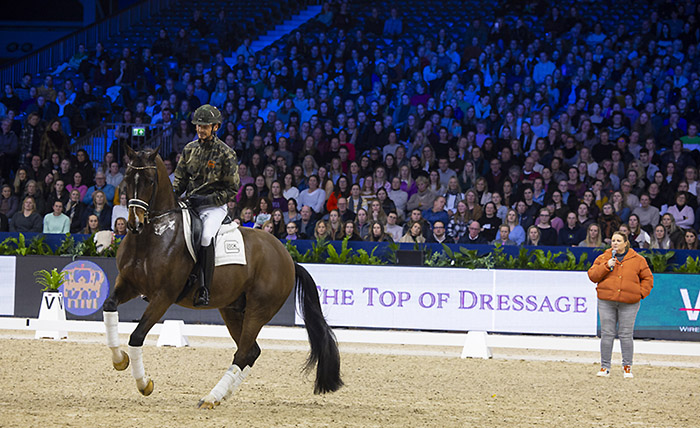
The Amsterdam crowd warmly welcomed back Eddie, as he is now being described on the Glock website, and under Nicole’s supervision, he worked a twelve-year-old stallion, Gladiator, by, of course, Totilas, out of a Havidoff mare. The ride is a new one for Edward, and Gladiator last competed with Geert-Jan Raateland in April 2022 at a 3 star in Belgium for a 16th in the Grand Prix (65.413) and a 7th in the Freestyle (66.916). The stallion is no Totilas, perhaps the most striking aspect of the demonstration was Edward’s choice of outfit, a camouflage jacket paired with a bright green crash hat. Was it perhaps a comment on the war in the Ukraine?
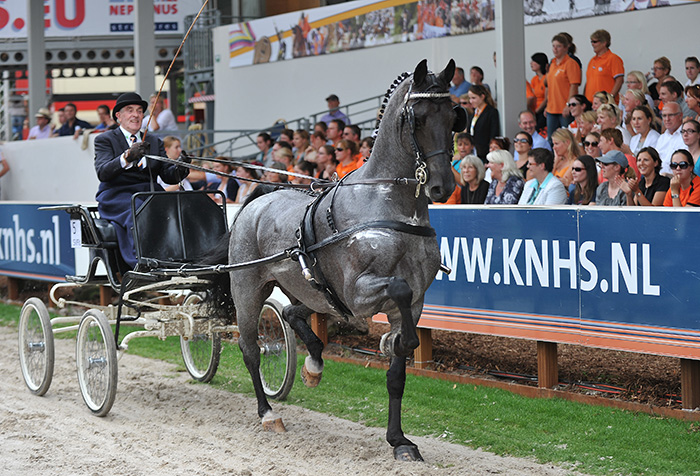
The Dutch spectators have seemingly been conditioned by the extravagant over-the-top displays by their harness horses, and like their dressage to be in a similar vein, displays like this Masterclass might help educate them to appreciate that there is more to dressage than spectacular trots. At the Masterclass there was certainly no sign of Joep’s special techniques only to be used by brilliant riders, and for that we give thanks, but for that matter we saw hardly any forward/downward (it was more up and short), has the reaction to Sjef gone too far in the opposite direction?
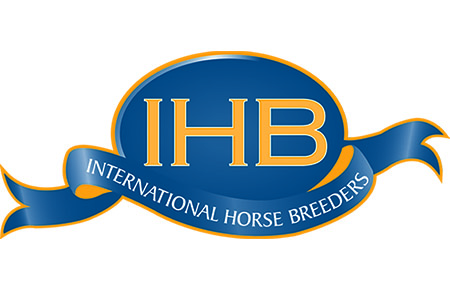
Breeding your own dressage star in Australia this season? For a great range of top European bloodlines, go to www.ihb.com.au

A good analysis of old and new trends in the dressage world and the somewhat dubious Dutch contribution for these developments .
What is missing is more in depth influence the judges have/had on the development of these trends.
Breeders and competitors will produce what wins and the judges determine this.
It is obvious that what judges say and what they actually promote differ, are the ideals not compatible with competitive dressage or the judges are failing in their duty.
It will be interesting to have a judges view to this article.
“A lot of people are against our way of training because they think we over bend the horses and that will hurt the neck and the back, but two professors have conducted a research project, and soon there is an article to be published, and they have proved that riding the horse always up, is very dangerous for the horse, and riding them deep is very good for the horse, especially the neck and the flexibility. So what we did unconsciously in our training has now been proven very good for the horse’s well being.”
What happened to riding from back to front? This statement is so obnoxious I can hardly stand it.
On the first point, yes, David, I meant to more strongly sheet home the blame to the judges, it’s funny now you can’t find a judge who liked salinero and anky, yet, these are the judges who gave the horse record scores and gold medals. On the second point there is no contradiction between riding your horse long and low and riding from behind. I can’t think of a dressage trainer, and I’ve watched the best train, who does not start with some long, low stretching forward movement, and I am quite sure that the professors did make honest research and that their results are valid, the problem is that what they were shown, and Sjef’s theory, was very different from the very short, tight, chin of chest for protracted periods of time, that was the actual practice of Sjef’s training, had they seen that reality thenI have no doubt their conclusions would have been very different… Christopher Hector
Kate The technique of using neck flexions to influence the horse has been used by many trainers for generations.
When the extreme is applied it is only for a shortest period possible (and seldom in public) returning to a more conventional outline as soon as the desired effect is achieved .True carriage just like the book says , originate from better use of the hindleg with less restricting hands.
Somewhere along the line the “technique” became a “system” and the system became the “ goal”.
A practical horsemen accept that the horse can’t be locked in the perfect position all the time, and will apply variations to the neck’s Hight, roundness and contact pressure etc.
The riding style you advocate does exactly the opposite – It locks the horse in a vice of an unnatural position and then CHALLENGES the body of the horse to cope.
The consequence is ! the very physically capable horse copes, but the less gifted horse spends long periods in misery.
What happened to riding from back to front? This statement is so obnoxious I can hardly stand it. Funny the older I get the more TRUTHFULL I find it David Pincus
The judges are in control of what we see. What ever wins is going to be duplicated. Its that simple. We were all there to see horses that didn’t halt get 7.5, horses that had no extension of the body in extended gaits get 8s, horses that bounce behind croup high and don’t have a 2 beat in the piaffe get 8s. Until the judging is more accurate to reward riding from the back to the front, through the body, making sure the horse in the ring is elastic, using its power and ability, to pleasantly and willingly shift its weight to work in collection in one half halt (That’s what you’re judging)… we will continue to see horses in all kinds of disarray.
great article Chris – well researched, supported by your own observed performances and a balanced opinion – allowing the riders to justify / or not / their methods.
Like it or not, horses are not machines and we need to constantly learn and respect them.
PS i do personally dislike swishing tails and if i see this when riding mine i know that i have mucked up!
Great article.
But,
Just because 2 professors have something to say (are you kidding in scientific research 70% of papers are thrown out because of ethical problems which is a nice way of saying the research has been fudged…and we are seriously talking a small pool here aren’t we?) doesn’t mean what they say is correct. People are often so overtly impressed by a few letters. Biomechanics is not well understood by most people.
However, we know from humans that the most detrimental exercise for the human spine is a constant posture or ‘held’ position – we are designed to move, in a variety of ways, but not at EXTREMES of positions. And horses? Well is it commonsense to presume as a prey animal it’s even more important? Methiinks the said research is a bit ho hum but the point made is valid both ways – extremes of movement are bad (this of course is where most human spinal injuries occur) and sustained postures can be just as detrimental.
So – a little commonsense and logic. If in doubt, look to what we know of human biomechanics, and try not to be bamboozled by anyone- charismatic trainer or “eminent professor’…